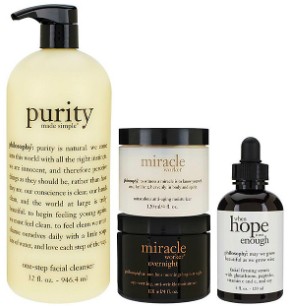
I’m often struck by the ways theology is mediated to us through our everyday encounters with consumer products. The theological is right there in the everyday, staring at us in the labels on our toothpaste tubes.
For example, there is the brand philosophy, a skin care company that makes heavy use of theological language. It has lotions called “hope in a jar,” “renewed hope in a jar,” and “when hope is not enough” (philosophy, perhaps ironically, doesn’t capitalize anything). There’s also the “ultimate miracle worker eye cream” and products called “purity made simple,” and “pure grace.”
Why does philosophy see theological language as rich ground for its advertising? Perhaps because theology and advertising share the same root: desire. “Thou hast formed us for thyself, and our hearts are restless till they find rest in thee” (Confessions, book 1). St. Augustine of Hippo made a bold pastoral move when he identified the human condition as one of wanting, of desiring. We human beings, in the ancient bishop’s eyes, are creatures defined by what we want. We are our longings, and absent God, in whom we’re meant to find rest, we are our restless hearts. We’re reduced to desire that will not be fulfilled.
Read our latest issue or browse back issues.
Philosophy knows this, because when it doesn’t name products after theological aspirations, it names them after food: vanilla birthday cake, coconut frosting. If God proves elusive, try food.
Advertising also gives us another clue about human longing: sin. In classical theological terms sin is desire gone awry. Thus the cosmetic brand Urban Decay features an eye shadow color called “sin” and an eye shadow primer in “minor sin.” The brand’s website offers “lust-worthy” palettes, a list of “most coveted” products, and a range of other colors that continue to evoke sin: snakebite, smog, naked, and free love. Many other cosmetic companies follow the same path: Nars has a blush in a shade it calls “sin” and a bronzer in a shade called “casino”; DuWop makes a lip “venom” called “2nd Sin.” I can cover all my facial features in sin.
Advertisers will continue to use theological language for products aimed at our bodies—and theologians should pay attention. Our hair, our skin, our armpits, and our faces are all sites for desire, and simultaneously for hope. Augustine knew that our human wanting is always spiritual and physical. So it’s no surprise that marketers elicit strong responses when they combine the mundane and the theological.
Theologians tend to forget that longing is both physical and spiritual. We mock advertisers’ paltry attempts to imitate theological language, and we ignore the fact that appealing to these longings is effective because the longings are real and physical.
But Christians find “hope in a jar” to be more preposterous than resurrection. The living God cannot be contained in a jar or a package any more than in a tomb. We choose to affirm that our deepest longing is for “the Spirit of him who raised Jesus from the dead,” and that “he who raised Christ from the dead [will] give life to our mortal bodies also” (Rom. 8:11).





